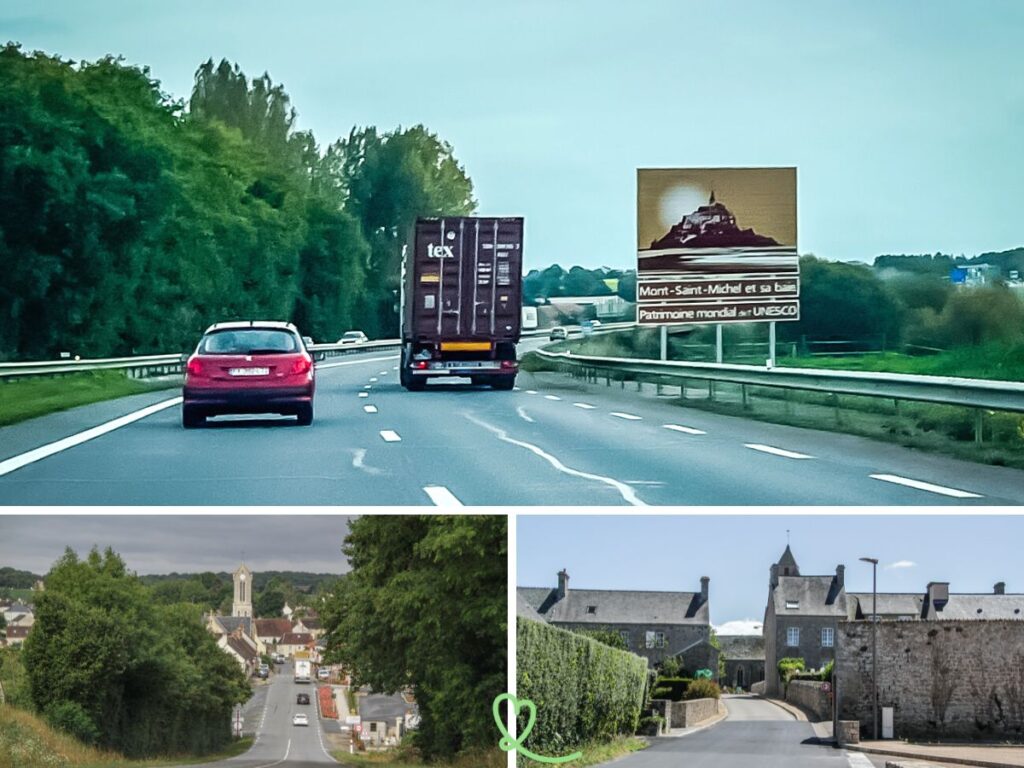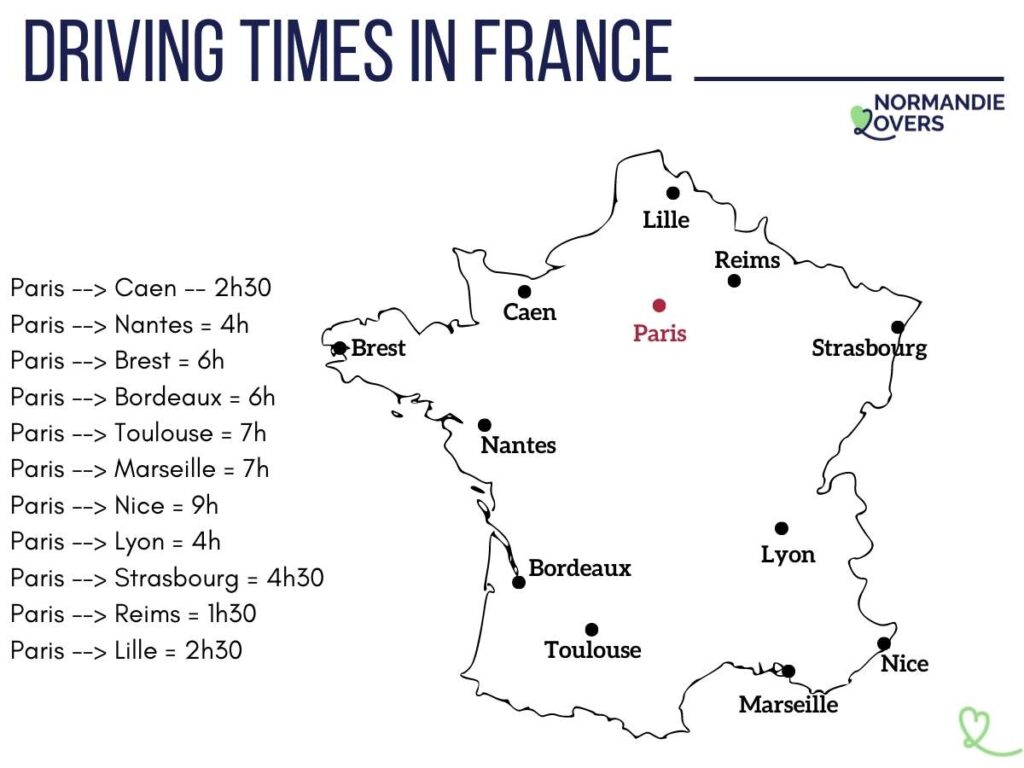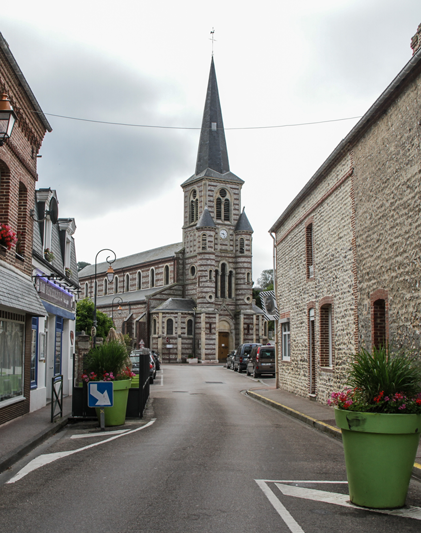France is an ideal country for a road trip: roads in good condition, beautiful countryside and variety of landscapes.
Here is our complete guide to driving in France, including :
- Is driving difficult? safe?
- Rules of conduct,
- Road conditions and safety tips,
- Parking information,
- Advice for car rental,
- The most regional not to be missed,
- …

Driving in France – What you need to know
What you need to know before driving in France
If you don’t want to read the whole article, at least read this short summary of the key points to know:
- Driving is on the right side of the road.
- The minimum driving age is 18, but some rental agencies may require drivers to be older.
- Seat belts are mandatory for all
- The blood alcohol level is 0.05%.
- The speed limits are well indicated in the red circle.
- Items to bring – reflective warning triangle, reflective vest
- In French cities, when you arrive at a crossroads, if there are no signs (stop or right of way), the vehicle coming from the street to the right of you has priority. And you have the right of way on the streets to the left.
- Do not enter the old city center or the old villages if you have a camper or a large van.
- In case of accident – emergency number: 112

Where we rent our cars
We always compare prices immediately at Discovercars.com.
It is one of the highest rated comparison sites in the market.
I have found some great deals and I find the platform super easy to use. I can filter according to my criteria.
Plus, they have a convenient coverage option at a great price that will cover you in case of damage to the exterior of the car.
See their current offers in France
Or see the offers directly at Roissy airport or Orly airport.
Do you need help? Read our 36 tips for a worry-free experience.

To visit France by car or not?
Do you need a car in France?
If you are staying in Paris just for a few days (or in another big city like Lyon or Bordeaux), then you do not need a car. Public transport in the main French cities is excellent.
However, as soon as you want to explore a little more and discover the charm that France has to offer with its villages, vineyards, mountains and breathtaking coastline, then a car is the best way to get around.
Is driving in France difficult? Is it dangerous?
Overall, it is quite easy to drive in France.
The roads are in good condition. There is a vast network.
However, be aware of the following difficulties:
- Driving in Paris is like a nightmare, especially the traffic circle around the Arc de Triomphe
- Driving around some of the major cities can be difficult as well, due to traffic.
- Some streets in town centers and old villages can be narrow
- Most foreigners will find that parking is the most difficult part of driving in France.
Remember that on the Internet, the hundreds of thousands of people who have had no problems do not take the time to write that everything was fine.

Getting around France without a car
It is possible to travel in France without a car, to see the main tourist sites:
- Train –
the rail network in France is well developed. You can get to many cities, especially from Paris – see train offers - Bus –
There is a public transport network - Organized day trips –
There are several companies that organize tours: historical, gastronomic, tourist… especially if you stay in Paris – see options.
Driving times in France – Map
To help you decide whether to rent a car or not, here is a map of driving times in the country.
The driving times are those of the freeways (with tolls).

OUR ADVICE FOR RENTING A CAR IN Normandy
- Compare prices on our preferred platform: DiscoverCars – one of the best rated sites.
- Choose a car that is comfortable enough (distances can be long) but compact (some parking lots and villages are narrow).
- Think of thecomplete insurance (some roads are tortuous and narrow).
- There is a lot of demand, book it early.

1 to 6 – Rules of conduct in France
Let’s start with the general rules and regulations you need to know:
#1 – License Requirement / Age – Do I need an International Driving Permit?
To be allowed to drive in France (for a short stay), you can use a standard international driving permit. This means a license that has:
- a license number,
- a photograph,
- a validity date,
- and is written in Latin letters.
A valid U.S. driver’s license will work.
A valid Canadian driver’s license is required.
A valid British driver’s license will work.
All European driving licenses work.
An Australian driver’s license works.
…
You must also carry identification and proof of liability insurance at all times.
In terms of age, you can drive from 18 years old (however, to rent a car, the minimum age is 21).

#2 – Side of the road
In France, driving is done on the right side of the road.
This means that when you enter a traffic circle, you go to the right.
#3 – General Rules of Conduct
- Seat belts are mandatory for all
- No cell phones while driving
- Children under 10 years of age cannot sit in the front seat of the car
- If an intersection does not have a sign or indication, you yield the right of way to the person coming from your right
- Traffic on the traffic circle has priority
- The use of the horn is only allowed in case of immediate danger (although the French tend to forget this rule)
#4 – Alcohol and Driving
The legal limit for driving is 0.05% alcohol in the blood.
I always recommend not drinking at all if you are driving.

#5 – Mandatory equipment to have in your car
In France, the following equipment must be available in the car:
- Safety triangle
- Reflective vest or jacket
In some regions of France, the new mountain law applies. Winter tires or chains are mandatory but during the winter months.
#6 – Mandatory insurance
The compulsory insurance in France is the civil liability insurance – it is automatically included in the price of all car rentals.
If you come with your own car, don’t forget to bring proof of insurance.
Compare car rental prices in France
#7 to 15 – Road conditions and signs in France – is driving difficult?
Okay. Now we come to the big question on everyone’s mind.
Is it difficult to drive in France?
#7 – French highways
France has a vast network of highways.
They are identified by the letter A before the number.
They have at least 2 lanes in each direction and progressive exits and entries.
Tolls are applicable on almost all freeways in France.
The speed limit is 130km/h.

#8 – French secondary roads
Secondary roads are called “National” and “Departmental” roads.
They are generally wide with one lane in each direction.
They connect the cities between them.
The limit is 80km/h most of the time.

#9 – Small country roads
Once you have explored the countryside, you may find much smaller roads without lines in the middle.
Be careful because the locals tend to drive too fast on these roads.
Slow down on blind curves.

#10 – Mountain roads
In some regions, France has high mountains: Alps, Pyrenees, Corsica…
Overall, even in the mountains, the roads remain in good condition with one lane in each direction.
Some sections can be quite steep.

#11 – Driving in small towns and villages
Nothing special to know about driving in cities and towns (except for the priority system – see tip #17).
The limit is 50km/h from the moment you see the sign indicating the beginning of a town (name in a rectangle with a red border).

#12 – Driving in Paris
In Paris, it’s a different story: so many cars, bikes, motorcycles, scooters…
The craziest place to drive in Paris is the traffic circle around the Arc de Triomphe.
Paris deserves a completely different article.
I recommend that you do not use a car during your stay in Paris.
#13 – Speed limits and signs
- Speed limits are indicated on circular signs with a red border and a number
- Speed limits are expressed in kilometers per hour
- On highways, it is 130 km/h unless otherwise indicated.
- Speed limits are – 30 to 50km/h in residential areas
Be careful, there are radars. There are even many around the Mont-Saint-Michel.

#14 – Road signs in France
The road signs are quite clear and use the Latin alphabet.
In some regions, you may have a second name in the local dialect

#15 – Tolls in France
There are many tolls in France.
If you want to use the highways and some bridges, you will have to pay.
However, you can avoid the highways and take smaller roads through the countryside. It will take more time but cost less.
You may have to pay for each of them. Or you can take a ticket at the entrance and pay at the exit.
Look at the icons at the top. The T is for those who have a special label. Some lanes are dedicated to them.

Subscribe to our Newsletter
- Get away from it all with Region Lovers’ beautiful destinations!
- Once a month
- Advertising-free
#16 to 18 – How to drive safely
#16 – Know the potential hazards
In general, driving in France is pleasant.
Our 3 warnings for you are:
- Be careful in summer, during weekends, traffic jams can be extreme on the main highways. Take water and food with you.
- Watch out for cyclists on secondary and country roads
- In the small roads of the region, the locals can drive a little too fast

#17 – The French “Priority on the Right
Pay attention to an unfamiliar rule.
In French cities, when you come to a crossroads, if there are no stop signs or priority signs at all, then the vehicle coming from the street to the right of you has the right of way. And you have the right of way on the streets to the left.
#18 – What to do in case of an accident
If people are injured or if there is a conflict, the emergency number is 112 :
The best order of action is:
- contact emergency services
- contact the police
- contact your rental provider
#19 to 20 – Parking in France
#19 – Parking in the city
In the cities, you can find different types of parking lots:
Outdoor parking and street parking
Often paid, but can be free when they are far from the stores.
Look for the machines to pay.
More and more cities also have applications that allow you to pay from your smartphone.
Keep a picture of your car when you go to the machine as some ask you to enter the license plate number.
Blue Zones
If you are parked in an area where the spaces are marked with a blue line, it is normally a blue zone and you must use a disc that indicates your arrival time. Generally, these areas allow you to stay for 15 or 30 minutes. These areas tend to disappear.
Underground parking lots
Large cities also have underground parking garages where you take a ticket on your way in and pay before you leave.

#20 – Parking at beaches and attractions
On beaches and attractions, parking rules vary.
Many have free parking.
However, the most important ones, such as Versailles or Mont Saint-Michel, will be costly.
Always look around for signs and machines.

Do not make
THE SAME MISTAKE WE MADE
On one of our last trips to Europe, a hacker stole our credit card details while we were using a hotel WiFi.
So our trip began with a “card blocked” call… Not funny at all!
Learn from our mistake, make a small VPN investment to surf without worry.

#21 to 22 – Service Stations
#21 – Fuels and their names
- The gasoline is called “Unleaded Gasoline”.
- Diesel is called “Diesel” or “Gasoil”.
- The gas station is called “Service Station”.
- LGP is GPL
- See the concentration of charging stations for electric cars, where you go in France on this website
#22 – Service Station Management
Nothing to say about refueling in France.
There are many stations in the cities and along the highways.
They accept credit cards

#23 – The most beautiful regions to drive through in France
France is amazing in every field. You will rarely be bored driving there.
Our favorite regions to drive through:
- Normandy with an ancient and modern history – see the best landscapes in Normandy
- The Loire Valley between wine and castles
- The island of Corsica between mountains and beaches
- Brittany, with the most beautiful coastline in France
- Alsace-Lorraine with its beautiful villages
- Provence with the sun, flowers, beaches and charming villages
- Annecy and the surrounding mountains
- The gorges of the Ardèche
- …

PLAN YOUR TRIP TO Normandy
Inspiration destinations
- Deciding where to go in Normandy – the best destinations
- Our weekend ideas: best-of, romantic, unusual, seaside, luxury, family
- 16 seaside hotels in Normandy
- The most beautiful charming hotels in Normandy

Best of

Practice
- Where to stay in Normandy – best places and hotels
- See our tips for renting a car at CDG airport, Orly airport, Beauvais airport, Caen, Rouen, Bayeux…

#24 to 27 – Tips for renting a car in France
Here is an overview of the main things you need to know.
You can find all our tips in this other complete guide to renting a car in France.
#24 – Which vehicle to rent ?
I know it depends on how many people are traveling and how much luggage you are taking.
But here are a few things to keep in mind when traveling to France:
- The roads are narrow in the countryside, villages and old centers. In addition, parking spaces can seem tight for travelers.
Therefore, I recommend choosing a car that is not too big, in order to reduce the stress of certain situations - If you are heading to the mountains (Pyrenees or Alps), the roads can be steep.
Therefore, it is more comfortable to have enough power. I recommend not to choose the smallest engine - Otherwise, no particular recommendations
#25 – Where to rent your car in France
The largest car rental centers in France are :
- Roissy Charles de Gaules Airport – see the car rental offers
- Orly Airport – see car rental offers
- Paris Gare de Lyon – see the carrental offers
- Nice Airport – see the offers
- Lyon St Exupéry Airport – Low cost car rental
- Marseille Airport – see car rental offers
- Toulouse Blagnac Airport – see car rental offers
Most of the major international brands are available in France.
Compare car rental prices in France

#26 – Best car rental agency in France
We do not have a specific recommendation for a rental agency in France. There are no famous local companies with good results.
But you can find all the major brands in airports and ferry ports (Enterprise, Sixt, Alamo, Hertz…).
- Compare car rental prices on our favorite platform: Discovercars. com – one of the top rated comparison sites by customers.
- Each rental agency has a 10 point rating. It is an average of the scores given by actual customers.
- Book early to have a wide choice of vehicles!
Don’t forget that on Tripadvisor or Google for example, anyone can write a review even if they haven’t used the company.
#27 – General tips for a worry-free experience
There is no particular thing to do when you rent a car in France, no specific scam.
I recommend always doing these things, no matter where you rent:
- Take pictures of the car as you drive it
- Don’t forget to check the condition under the bumper of the car (look for scratches and take pictures)
- Don’t forget to check the condition of the roof (look for slumps and take pictures)
- Take pictures of the car when you leave it



